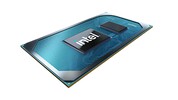Intel Core i7-1185G7 vs Intel Core i5-1035G1 vs Intel Core i7-1065G7
Intel Core i7-1185G7
► remove from comparison
The Intel Core i7-1185G7 is a power-efficient quad-core SoC for laptops and Ultrabooks based on the Tiger Lake-U generation (UP3) that was introduced September 2020. It integrates four Willow Cove processor cores (8 threads thanks to Hyper-Threading). Each core can clock from 1.2 GHz (12 W base clock speed), 3 GHz (28 W base clock speed) to 4.8 GHz (single-core boost). All cores at once can clock at up to 4.3 GHz. At the time of announcement, the i7-1185G7 is the fastest model of the line-up. Since early 2021, the i7-1185G7 supports management features like vPro.
Another novelty is the integrated Iris Xe iGPU based on the completely new Gen 12 architecture. It should offer a significantly higher performance compared to the older Iris Plus G7 (Ice Lake). In the i7-1185G7 it uses 96 EUs and clocks between 400 - 1,350 MHz. The GPU and CPU can together use the 12 MB of L3 cache.
Furthermore, Tiger Lake SoCs add PCIe 4 support (four lanes), AI hardware acceleration, and the partial integration of Thunderbolt 4/USB 4 and Wi-Fi 6 in the chip.
Performance
The average 1185G7 in our database is just as fast as AMD's hexa-core Ryzen 5 4500U, as far as multi-thread benchmark scores are concerned. While the i7 is not the fastest Tiger Lake chip by any stretch of imagination, it's more than usable for your productivity and creative apps, with a bit of gaming possible as well.
Thanks to its decent cooling solution and a long-term CPU power limit of 55 W, the Stealth 15M A11SEK is among the fastest laptops powered by the 1185G7 that we know of. It can be almost twice as fast in CPU-bound workloads as the slowest system featuring the same chip in our database, as of August 2023.
Power consumption
This little Core i7 here has a default TDP of 12 W to 28 W, the expectation being that laptop manufacturers will go for a higher value in exchange for higher performance. Either way, that's a tad too high to allow for passively cooled designs.
The chip is manufactured on Intel's third-gen 10 nm process marketed as SuperFin for average, as of late 2022, energy efficiency.
Intel Core i5-1035G1
► remove from comparison
The Intel Core i5-1035G1 is a low-power, Ice Lake family processor (SoC) featuring 4 cores, 8 threads, 6 MB of L3 cache and the UHD G1 (32 EUs) iGPU. It saw the light of day in H2 2019. The chip is designed for use in highly portable laptops; its CPU cores run at 1.0 GHz to 3.6 GHz, with only 3.2 GHz achievable if all the cores are loaded.
Unlike the costlier Core i5-1035G4, the 1035G1 has the 32 EU UHD Graphics G1 iGPU at its disposal as opposed to the more powerful 48 EU Iris Plus G4; CPU cores run at a slightly lower clock rate in the case of the 1035G1, too.
Architecture & Features
Ice Lake family chips are powered by Sunny Cove CPU cores.The latter aim to do what Palm Cove cores (that we never really got a chance to get a taste of) were expected to do, delivering a double-digit IPC uplift over the venerable Skylake architecture thanks to a range of small improvements across the board including scheduler improvements, larger caches and buffers, and support for new instruction sets.
Thunderbolt 3 support is built right into the Core i5 (meaning the latter has several PCIe 3 lanes exclusive to Thunderbolt devices, reducing the number of additional components required for Thunderbolt to work) and so is Intel CNVi Wi-Fi 6 support (making it easier for Intel to sell its proprietary WLAN cards to laptop makers). The Core i5-1035G1 also has the DL Boost and GNA features for applications centered around machine learning.
The 4 GT/s bus is indicative of a consumer-grade chip, since CPUs for gaming laptops and portable workstations usually employ the faster 8 GT/s bus. RAM support is nothing to sneeze at, at up to DDR4-3200 or LPDDR4-3733. NVMe SSDs are supported, with data transfer rates limited to 3.9 GB/s (this is what four PCIe 3 lanes are good for). SATA drives and even eMMC chips are also natively supported here.
This is not a user-replaceable CPU, as it gets permanently soldered to the motherboard (BGA1526 socket interface).
OS support is limited to 64-bit Windows 10 and Windows 11, as well as many Linux distros.
Performance
The Core i5-1035G1 is a lower mid-range CPU, as of mid 2022. It is good for more than just the basics while being no match for true high-performers such as the mighty Core i7-10850H.
According to our in-house testing, the Core i5 delivers multi-thread performance that is similar to what the Core i7-10610U, the Core i7-1160G7 and the Ryzen 5 PRO 3500U have to offer. Your mileage may vary depending on how competent the cooling solution of your system is and how high the CPU power limits are.
The Lenovo IdeaPad 5 15IIL05 is among the fastest laptops featuring the 1035G1 that we have tested.
Graphics
The UHD Graphics G1 is based on Intel's Gen 11 architecture. The UHD Graphics runs at up to 1,050 MHz and has 32 EUs for fairly unimpressive performance; the Iris Plus G4 has 48 EUs while the Iris Plus G7 has 64 EUs, for reference. This iGPU will drive up to 3 monitors simultaneously and is DX12-compatible. The resolution options are capped at 5120 by 3200. There is no hardware AV1 codec support here, meaning such a video will be SW-decoded with rather low energy efficiency. The usual HEVC, AVC and VP9 codecs are supported, thankfully.
The UHD Graphics is significantly faster than the UHD Graphics 620, yet it's still not as good as a proper discrete graphics card would be. It will let one play certain games, F1 2020 included, provided one is content with the 720p resolution and low quality settings.
Power consumption
The Core i5-1035G1 has a default TDP (also known as the long-term Power Limit) of 15 W. Laptop makers are free to increase that value somewhat, with 25 W being the upper limit, or reduce it (values as low as 13 W are possible). Clock speeds and performance will change accordingly as a result. Either way, an active cooling solution will be required to dissipate the heat.
The chip is manufactured on Intel's second-generation 10 nm process (not "10 nm SuperFin" or "Intel 7") for average, as of late 2022, energy efficiency.
Intel Core i7-1065G7
► remove from comparison
The Intel Core i7-1065G7 is a power efficient quad-core SoC of the Ice Lake U product family designed for thin laptops and Ultrabooks. It was announced in May 2019 (Computex). The CPU has four Sunnycove processor cores (8 threads thanks to Hyper-Threading) clocked at 1.3 (base) - 3.9 (single core Turbo) GHz. 2 cores can reach 3.8 GHz and all four 3.5 GHz using Turbo Boost. According to Intel the Sunnycove cores achieve 18% more IPCs (Instructions per Clock).
Other improvements for Ice Lake are the AI hardware acceleration and the partial integration of Thunderbolt and Wi-Fi 6 in the chip. The integrated DDR4 memory controller supports modules with up to 3200 MHz (and LPDDDR4 3733).
The biggest improvement of Ice Lake is the integrated Gen 11 graphics adapter called Iris Plus Graphics. The Core i7-1065G7 integrates the biggest G7 variant with 64 EUs clocked at 300 - 1100 MHz. The Iris Plus G7 should be twice as fast as the predecessors and best the AMD Vega 10 GPU from current Ryzen APUs.
Performance
The average 1065G7 in our database is most comparable to the AMD Ryzen 7 2700U and the Intel Core i5-8259U, as far as multi-thread benchmark scores are concerned. This is a so-so result and a direct consequence of Intel's inability to make the best of its brand-new 10 nm node. The Core i7-10710U, a 10th generation processor built with an older 14 nm process, will easily rip a 1065G7 to pieces. That said, the 1065G7 will surely beat a 10710U in terms of energy efficiency.
Thanks to its decent cooling solution and sufficiently high CPU power limits, the Galaxy Book Flex 15-NP950 is among the fastest laptops powered by the 1065G7 that we know of. It can be around 40% faster in CPU-bound workloads than the slowest system featuring the same chip in our database, as of August 2023.
Power consumption
This Core i7 has a default TDP, also known as the long-term power limit, of 15 W. Laptop makers are free to change that value to anything between 12 W and 25 W with clock speeds and performance changing accordingly as a result. Either way, that's a tad too high to allow for passively cooled designs.
The quad-core Intel CPU is built with Intel's second-gen 10 nm process (not 10 nm SuperFin or Intel 7) for average, as of late 2022, energy efficiency.
| Model | Intel Core i7-1185G7 | Intel Core i5-1035G1 | Intel Core i7-1065G7 | ||||||||||||||||||||||||||||||||||||||||||||||||||||||||||||||||||||||||||||||||
| Codename | Tiger Lake-UP3 | Ice Lake-U | Ice Lake-U | ||||||||||||||||||||||||||||||||||||||||||||||||||||||||||||||||||||||||||||||||
| Series | Intel Tiger Lake | Intel Ice Lake | Intel Ice Lake | ||||||||||||||||||||||||||||||||||||||||||||||||||||||||||||||||||||||||||||||||
| Series: Ice Lake Ice Lake-U |
|
|
| ||||||||||||||||||||||||||||||||||||||||||||||||||||||||||||||||||||||||||||||||
| Clock | 3000 - 4800 MHz | 1000 - 3600 MHz | 1300 - 3900 MHz | ||||||||||||||||||||||||||||||||||||||||||||||||||||||||||||||||||||||||||||||||
| L1 Cache | 320 KB | 192 KB | 192 KB | ||||||||||||||||||||||||||||||||||||||||||||||||||||||||||||||||||||||||||||||||
| L2 Cache | 5 MB | 2 MB | 2 MB | ||||||||||||||||||||||||||||||||||||||||||||||||||||||||||||||||||||||||||||||||
| L3 Cache | 12 MB | 6 MB | 8 MB | ||||||||||||||||||||||||||||||||||||||||||||||||||||||||||||||||||||||||||||||||
| Cores / Threads | 4 / 8 | 4 / 8 | 4 / 8 | ||||||||||||||||||||||||||||||||||||||||||||||||||||||||||||||||||||||||||||||||
| TDP | 28 Watt | 15 Watt | 15 Watt | ||||||||||||||||||||||||||||||||||||||||||||||||||||||||||||||||||||||||||||||||
| Technology | 10 nm | 10 nm | 10 nm | ||||||||||||||||||||||||||||||||||||||||||||||||||||||||||||||||||||||||||||||||
| max. Temp. | 100 °C | 100 °C | 100 °C | ||||||||||||||||||||||||||||||||||||||||||||||||||||||||||||||||||||||||||||||||
| Socket | BGA1449 | BGA1526 | BGA1526 | ||||||||||||||||||||||||||||||||||||||||||||||||||||||||||||||||||||||||||||||||
| Features | DDR4-3200/LPDDR4x-4266 RAM, PCIe 4, 4 GT/s bus, DL Boost, GNA, MMX, SSE, SSE2, SSE3, SSSE3, SSE4.1, SSE4.2, AVX, AVX2, AVX-512, BMI2, ABM, FMA, ADX, VMX, SMX, SMEP, SMAP, EIST, TM1, TM2, HT, Turbo, SST, AES-NI, RDRAND, RDSEED, SHA, TME | DDR4-3200/LPDDR4-3733 RAM, PCIe 3, 4 GT/s bus, DL Boost, GNA, MMX, SSE, SSE2, SSE3, SSSE3, SSE4.1, SSE4.2, AVX, AVX2, AVX-512, BMI2, ABM, FMA, ADX, VMX, SMEP, SMAP, EIST, TM1, TM2, Hyper-Threading, Turbo, SST, AES-NI, RDRAND, RDSEED, SHA, SGX | DDR4-3200/LPDDR4-3733 RAM, PCIe 3, 4 GT/s bus, DL Boost, GNA, MMX, SSE, SSE2, SSE3, SSSE3, SSE4.1, SSE4.2, AVX, AVX2, AVX-512, BMI2, ABM, FMA, ADX, VMX, SMEP, SMAP, EIST, TM1, TM2, Hyper-Threading, Turbo, SST, AES-NI, RDRAND, RDSEED, SHA, SGX | ||||||||||||||||||||||||||||||||||||||||||||||||||||||||||||||||||||||||||||||||
| iGPU | Intel Iris Xe Graphics G7 96EUs (400 - 1350 MHz) | Intel UHD Graphics G1 (Ice Lake 32 EU) (300 - 1050 MHz) | Intel Iris Plus Graphics G7 (Ice Lake 64 EU) (300 - 1100 MHz) | ||||||||||||||||||||||||||||||||||||||||||||||||||||||||||||||||||||||||||||||||
| Architecture | x86 | x86 | x86 | ||||||||||||||||||||||||||||||||||||||||||||||||||||||||||||||||||||||||||||||||
| Announced | |||||||||||||||||||||||||||||||||||||||||||||||||||||||||||||||||||||||||||||||||||
| Manufacturer | ark.intel.com | ark.intel.com | ark.intel.com |
Benchmarks
Average Benchmarks Intel Core i7-1185G7 → 100% n=41
Average Benchmarks Intel Core i5-1035G1 → 68% n=41
Average Benchmarks Intel Core i7-1065G7 → 79% n=41
* Smaller numbers mean a higher performance
1 This benchmark is not used for the average calculation












